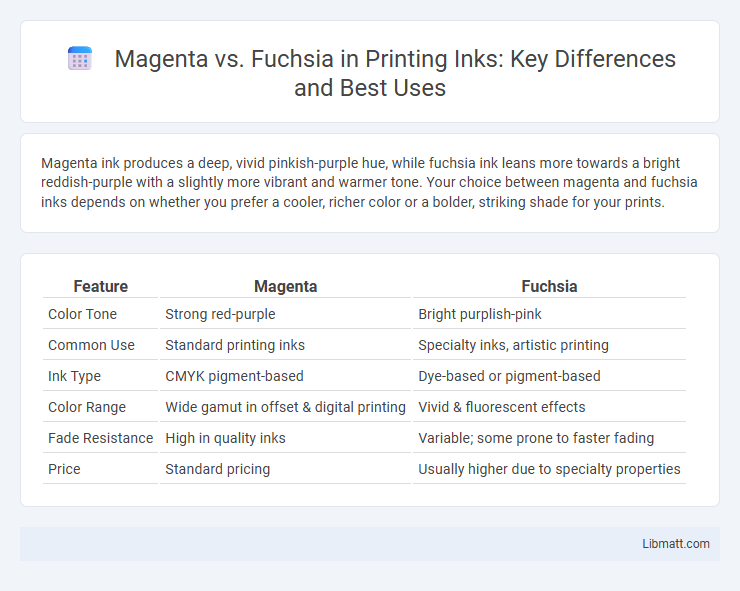Magenta ink produces a deep, vivid pinkish-purple hue, while fuchsia ink leans more towards a bright reddish-purple with a slightly more vibrant and warmer tone. Your choice between magenta and fuchsia inks depends on whether you prefer a cooler, richer color or a bolder, striking shade for your prints.
Table of Comparison
| Feature | Magenta | Fuchsia |
|---|---|---|
| Color Tone | Strong red-purple | Bright purplish-pink |
| Common Use | Standard printing inks | Specialty inks, artistic printing |
| Ink Type | CMYK pigment-based | Dye-based or pigment-based |
| Color Range | Wide gamut in offset & digital printing | Vivid & fluorescent effects |
| Fade Resistance | High in quality inks | Variable; some prone to faster fading |
| Price | Standard pricing | Usually higher due to specialty properties |
Introduction to Magenta and Fuchsia Inks
Magenta ink features a vibrant, reddish-purple hue crucial for producing rich, full-color images in printing processes. Fuchsia ink, slightly lighter and more vivid, is often used for more intense, eye-catching designs and blends seamlessly in color mixing. Your choice between magenta and fuchsia inks impacts the saturation and tone of printed materials, affecting color accuracy and visual appeal.
Defining Magenta: Origins and Characteristics
Magenta, originating from the 19th century dye industry, is a vivid purplish-red hue essential in CMYK color printing for producing a wide spectrum of colors. This ink's balanced blend of red and blue pigments allows for high saturation and strong color mixing capabilities without leaning too far into pink or purple extremes. Your print projects benefit from magenta's precise tone, which offers vibrant, accurate reproductions essential for professional-quality imagery.
Understanding Fuchsia: Color Profile and History
Fuchsia, a vibrant color blending red and blue hues, originated from the pigment derived from the fuchsia flower, introducing a distinct magenta shade to the color spectrum. Its color profile in inks typically leans toward a cooler, bluish-magenta compared to magenta's warmer, redder tone, making it essential for designers seeking precise color accuracy in prints. Understanding fuchsia's unique chromatic properties helps you achieve rich, dynamic visuals in various printing applications, differentiating it clearly from traditional magenta ink.
Chemical Composition: Magenta vs Fuchsia Inks
Magenta inks primarily consist of quinacridone or dye-based pigments, known for their strong red and blue spectral components, creating a vivid, saturated hue essential for color mixing in printing. Fuchsia inks, while similar in chemical basis, often incorporate additional red dyes or pigments, such as rhodamine derivatives, to achieve a brighter, more fluorescent appearance. The differences in chemical composition influence their color intensity, UV stability, and suitability for various printing techniques, with magenta providing a deeper tone and fuchsia offering a strikingly vibrant finish.
Color Science: Visual Differences Between Magenta and Fuchsia
Magenta and fuchsia, though often confused, differ in their visual impact due to distinct color profiles; magenta is a primary subtractive color with a balanced blend of red and blue light, while fuchsia is a more saturated, vibrant hue leaning towards pink with higher red content. In ink formulation, magenta serves as a critical component in CMYK printing, enabling a wide range of color reproduction, whereas fuchsia inks produce a brighter, more vivid finish aimed at artistic and decorative applications. The spectral reflectance curves of magenta exhibit a broader absorption in green wavelengths, contrasting with fuchsia's narrower absorption peak that emphasizes its intense pinkish appearance.
Printing Applications: Choosing the Right Ink
Magenta ink is widely used in commercial printing for its ability to produce vibrant reds and pinks, making it essential for color accuracy in brochures and magazines. Fuchsia ink, with its slightly purpler hue, excels in creative and artistic prints where vivid and unique coloration is desired. Choosing the right ink depends on your printing needs; magenta suits standard color reproduction, while fuchsia enhances designs requiring more intense, cooler pink tones.
Pigment and Dye Variations in Magenta and Fuchsia
Magenta inks primarily use a combination of pigment-based and dye-based colorants, with pigments offering better lightfastness and durability while dyes provide brighter and more vibrant hues. Fuchsia inks, often leaning towards dye formulations, showcase more intense color saturation but typically sacrifice longevity and resistance to fading compared to pigmented magentas. The pigment variations in magenta result in muted, stable tones ideal for archival purposes, whereas fuchsia's dye variations deliver vivid and eye-catching colors suited for short-term displays.
Popular Uses in Art and Design
Magenta and fuchsia inks are both vibrant pink hues widely used in art and design for their eye-catching properties. Magenta is favored in printing and graphic design to create bold, dynamic visuals due to its balanced red-blue spectrum that enhances contrast and color depth. Fuchsia inks appeal to artists focusing on floral, fashion, and modern art, offering a slightly purpler tone that adds a unique vibrancy to your creative projects.
Lightfastness and Durability Comparison
Magenta inks generally exhibit higher lightfastness compared to fuchsia, maintaining color integrity longer under exposure to sunlight and UV radiation. Fuchsia inks often fade more quickly due to their composition, resulting in reduced durability in applications requiring longevity. For archival or outdoor use, magenta is preferred for its superior resistance to fading and environmental wear.
Tips for Selecting Magenta or Fuchsia Ink
Choose magenta ink for rich, deep reds and purples, ideal for professional printing and photographic accuracy. Opt for fuchsia ink when vibrant, bright pinks and purples are needed in fashion design or creative artwork. Always test ink compatibility with your printer model and paper type to ensure optimal color vibrancy and durability.
Magenta vs Fuchsia (in inks) Infographic

 libmatt.com
libmatt.com